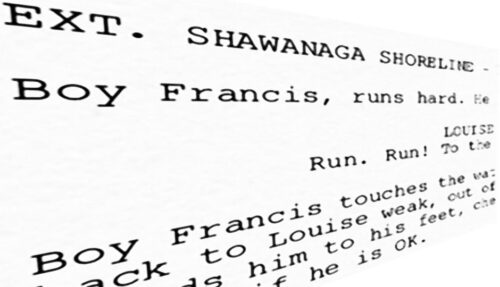The Screenplay is the blueprint for the entire production and every department and every person on the shoot relies on it as a guide and instruction manual for the story that is being told.
Contributed By Glen Berry, Edited by Stavros C. Stavrides
Important Concepts
- Format Your Script Properly
- Script Writing Apps Help
- Scripts are comprised of Three Main Parts
- Do Not Direct From Your Keyboard
The Script as Blueprint
Screenplays have a very specific format and for good reason. The script is the blueprint for the entire production and every department and every person on the shoot relies on it as a guide and instruction manual for the story that is being told.
An entire list of rules of thumb can be extrapolated from the screenplay. One page of script equals one minute of the finished film. One page of script equals one hour of work editing to reach a rough cut. Many productions aim to shoot four pages of script in one day. The list goes on and on.
All of this depends on the script being properly formatted, however. Professionals working in this industry have a zero-tolerance policy for badly formatted scripts. Experienced script readers can flip through the entire script in a second by fanning the pages and tell whether it is formatted correctly or not.
Forgetting simple things like putting a period at the end of your page numbers is enough to get your script rejected. If you don’t know how to do something like that, or you didn’t bother to research it, the inference is that you won’t know how to create a “smart” screenplay and know nothing about the business.
Not only is applying proper formatting critical to all later stages of the production, but it is also critical to even get your script read by anyone experienced in the industry. Not knowing to format is a fatal amateur mistake.
The “Rules”
Script formatting is dictated by the Writer’s Guild of America.
However, in the words of Einstein: “Never memorize what you can look up in books.” Or even better yet, never memorize formatting rules if you can get software that will automatically apply them for you.
That said, scriptwriting programs will not make you a better writer. They won’t make your concepts any good. They will improve your speed at writing if you already know what you want to write. They will also force you to conform to formatting rules, provided you know what they are.
This post is reformatted from a section of the “Screenwriting” chapter in Cyber Film School’s Multi-Touch Filmmaking Textbook
Final Draft is the industry standard in Hollywood. Many of the scripts that we receive are in Final Draft format or PDF. Final Draft can generate a PDF file. Whatever your choice of software, keep in mind that there are only three main components to the screenplay:
- Scene Heading
- Dialogue
- Action, or ‘Scene Description’

Scene Heading
The scene heading denotes a change in time or space and usually consists of three parts: Interior or Exterior notation (INT/EXT). The location (OCEAN BEACH) and the time of day if it is an exterior (DAY or NIGHT). Like so:
EXT. SHAWANAGA SHORELINE – DAY
Action (Scene Description)
Action does not simply mean people running or shooting at each other. Action is anything that is not dialogue. The action could read like this:
Boy Francis touches the water and turns around. He arrives back to Louise weak, out of breath, and near collapse. Louise stands him to his feet, checks him over, and looks him in the eye to see if he is OK.
A layperson would not describe this scene as an ‘action scene’, but it is in fact comprised of all action and no dialogue.
The more action you have in your script, the more visual it will be in its storytelling style and the more cinematic it will be.
Dialogue
Dialogue denotes the speaker and the spoken line. Although dialogue is very often a critical component of story development, if you do not balance dialogue with action, you will end up with a piece that is more theatrical.
If your script is almost entirely dialogue, why not make it into a stage play? Movies are a visual medium, you ought to tell your story with images.
Here is a great article on the history of the screenplay format
‘MAKING SENSE OF THE SCREENPLAY FORMAT‘
Why the Courier Font?
The industry standard font for screenplays in Courier is 12-point. Yeah, we know, it resembles the typewriter front from the pre-digital era, but some things never change. Maybe it makes it readable. Maybe it’s tradition. Get back to us if you have an explanation.
Summary
- If you do not follow proper script formatting guidelines, you are sinking your ship before you even get it in the water.
- Scriptwriting programs will help you with speed and help you adhere to formatting guidelines; they will not make you a better writer.
- Leave the acting to the actors. Do not include parentheticals, notations on emotion, or any actions that do not directly advance the plot.
NEXT>>>
SCRIPT EVALUATION
Evaluating your script, taking feedback,
and the importance of re-writing.
<< BACK
CHARACTER DEVELOPMENT
Character – protagonists, antagonists, anti-heroes,
and their relationships to the story.


